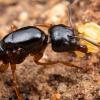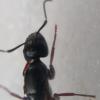I heard recently that local insect populations including those from Formicidae were declining, this was based on numbers attracted to black lights. This raised an interesting question in my mind that I have had since I first got into ant keeping. Do we as ant keepers inadvertently hurt some local populations that would have done better without our intervention?
According to Wikipedia "The young queens have an extremely high failure rate. During its lifetime a very large ant colony can send out millions of virgin queens. Assuming that the total number of ant colonies in the area remains constant, on average only one of these queens succeeds. The rest are destroyed by predators (most notably other ants), environmental hazards or failures in raising the first brood at various stages of the process. This strict selection ensures that the queen has to be both extremely fit and extremely lucky to pass on her genes to the next generation."
Another similar situation here (science.jrank.org): "In colonies with large populations, like that of the fire ant Solenopsis, hundreds of thousands of young queens take to the air in less than an hour, but only one or two individuals will survive long enough to reproduce. Most are taken by predators such as birds, frogs, beetles, centipedes, spiders, or by defensive workers of other ant colonies."
To an ant keeper, most of the ants he/she finds will be from a backlight or from the ground. This is fine as many queens are flying and rushing around already. But when a queen who has not only made it past the gauntlet of predators outlined above, including us, but also dug a nuptial chamber and possibly laid eggs gets taken by one of us, her species chances for allowing the species to live on decreases just a bit. But it adds up over time, over the years.
So for instance assuming a species hypothetically has 100 queens fly and only 5 of them successfully mate and dig a chamber. Out of those maybe 2 might live to have nanitics and who knows whether they will find food to feed their starving queen. So chances are extremely low for any of the queens to start a successful colony. So all in all the survival rate is very low, getting lower still with invasive species that these ants don't have defensive/survival mechanisms for. And we, the ant keepers, catching queens in their chambers does not help things at all.
Social insect colonies have survived for many millions of years, must longer then us humans. This is due in part to the genetic adaptation of kin selection where altruistic daughter workers give up their ability to reproduce and spread their genes in favor of combining all collected local resources and offering them to one or more individuals who have the ability to reproduce and make more sterile workers or more possible reproductives. This kin selection takes the place of natural selection for the individual, but the colony as a whole can be seen through the lens of natural selection. If the colony makes at least one successful daughter colony, the original colony has from a Darwinian perspective achieved what it was meant to do. All other sacrifices made by the workers and queen do not matter as long as another colony of the same species will take their place in the future.
To me, the practice of digging up queens that have already dug chambers for themselves could be seen as destroying the few queens that had a chance of starting their colonies. It does not matter if you take that queen and it makes a giant colony full alates, from an evolutionary standpoint, that queen and colony have failed due to no offspring being released successfully. Now of course allowing the reproductives to fly at their normal time due to environmental cues will allow this colony to reproduce and in fact help this species, by letting an unusual amount of alates fly.
One last point I want to make is that catching only native ants and not invasive species hurts the native species much more. When an invasive species encounters a native one, every colony, queen, worker and egg counts for that local group of colonies collective survival. Personally I see no problem with capturing invasive species as long as no members of the colony escape into the surrounding environment. As long as the colony does not reproduce, they have failed.
I know I probably sound like AC with "team invasive species and team natives" but I got to my conclusions separately. I do agree with him on this topic though, that native species need our help. Or at the very least they don't need us working against them by taking their populations, opening the way for invasive domination.
My point to all this was not to write an essay, which I ended up doing, but to point out that perhaps a conscious limit should be put in place when gathering queens, specifically digging up founding chambers and collecting any form of colony, especially mature ones.
Open to any other thoughts and opinions,
-thanks
Edited by AntsUtah, February 4 2021 - 6:40 PM.






















